While walking along the sea embankments and glimpsing into the shallow water, we will certainly notice medium-sized fish moving at the bottom; their color is a perfect disguise. Most of these conspirators belong to the Gobiiformes order of the Percomorpha clade.
Until recently, Gobiiformes, as well as some other fish, were considered to be a suborder of the Perciformes order, but science is forging ahead and improving its classifications. So let’s drop the subject and leave it to the men of science, and continue the conversation about these lovely fish as relatives (although nowadays a little different) of the Perciformes order.

(Round goby. SSSR stamp, 1983. stamps.ru)
Gobiiformes are distributed mainly in the sea or brackish tropical and subtropical waters, some species are semi-migrating fish. About 10 percent of representatives of the order inhabit freshwater – they are the most numerous inhabitants of freshwater bodies on many oceanic islands. It used to be considered the most numerous suborder of sea fish (prior to the latest classifications).
Fish of the Gobiiformes order Schindleria brevipinguis, inhabiting the area near the Great Barrier Reef, were considered to be the smallest in the world until recently; the average length of males is only 7.9 mm. The largest fish of the order is marble goby (Oxyeleotris marmorata), which inhabits fresh and brackish waters of the Mekong and Chao Phraya (Menam) river basins and can be 65 centimeters long.

(Marble goby. Photo © teaktreefishingchiangmai.com)
The order currently comprises seven families and more than 2,200 fish species.
Gobioidei, inhabiting the Adriatic Sea, are small fish that mostly have bottom and ambush lifestyle. 45 representatives of only one family (the Gobiidae family) are found in the Adriatic.
The Gobiidae family comprises more than 1,100 fish species of 160 genera. They are distributed around the world and live in tropical and temperate climates. More often, they inhabit the sea, brackish and fresh waters of the coastal area. Most fish are not longer than 10 centimeters. Even the smallest species are predominantly carnivorous.
Transparent goby (Aphia minuta).
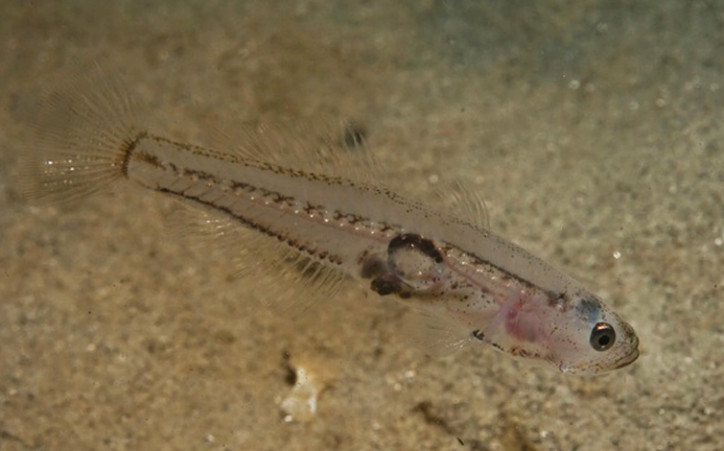
(Transparent goby. Photo by © Wijnand Vlierhuis. anemoon.org)
It inhabits at depths of up to 97 meters. It occurs above the sandy, silty and algae-covered bottom. The maximum recorded length is 7.9 cm. It feeds on zooplankton. It is a permanent inhabitant of the Adriatic Sea.

(Crystallogobius linearis. Photo by © Rudolf Svensen. nmsportsfiske.no)
It inhabits the depth of 1-400 meters. It is a pelagic species, sometimes occurs near the coast above a sandy and silty bottom. The maximum recorded length is 4.7 cm. It is a permanent inhabitant of the Adriatic Sea.
De Buen‘s goby (Buenia affinis).
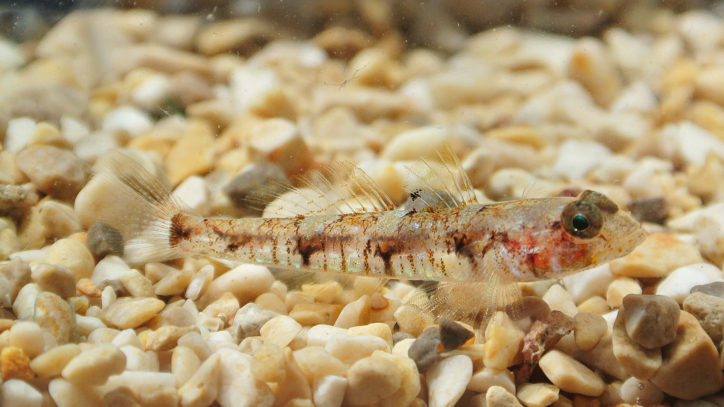
(De Buen’s goby. Photo by © Šárka Mašová. biolib.cz)
It inhabits the depth of 3-25 meters, usually 5-20 meters. It occurs above a sandy bottom with lonely stones. The maximum recorded length is 3.3 cm. This species in the Adriatic Sea is most commonly found in Kvarner Bay in Croatia, in other locations single meetings are registered.
Chestnut goby (Chromogobius quadrivittatus).

(Chestnut goby. Photo by © Robert A. Patzner. fishbase.org)
It occurs next to the coastal zone, hiding under stones and in the roots of vegetation. The maximum recorded length is 6.6 cm. It feeds on zooplankton. It is a permanent inhabitant of the Adriatic Sea.
Kolombatovic’s goby (Chromogobius zebratus).
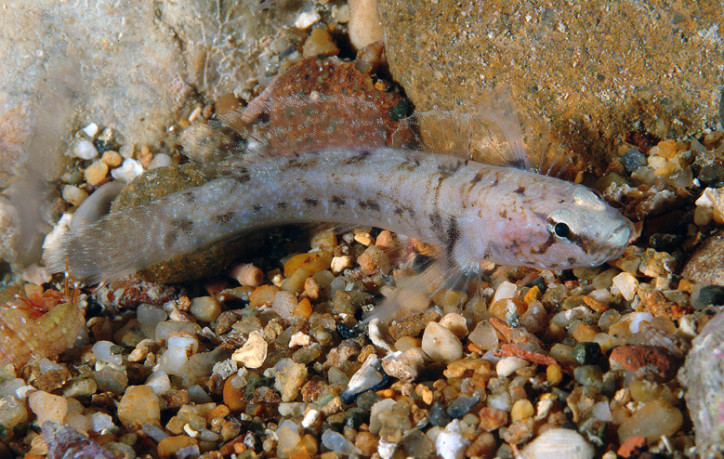
(Kolombatovic’s goby. Photo by © Stefano Guerrieri. naturamediterraneo.com)
It inhabits the coastal tidal zone. The maximum recorded length is 5.3 cm. It is a permanent inhabitant of the Adriatic Sea.
Liechtenstein‘s goby (Corcyrogobius liechtensteini).

(Liechtenstein’s goby. Photo by © Šárka Mašová. biolib.cz)
It inhabits the depth of 5-25 meters, hiding in crevices of rocks and empty shells. The maximum recorded length is 2.5 cm. It is a permanent inhabitant of the Adriatic Sea. A little-studied species, including due to its small size.
Toothed goby (Deltentosteus collonianus).

(Deltentosteus collonianus. Photo by © Sylvain le Bris. doris.ffessm.fr)
It inhabits at depths of up to 120 meters. It occurs mostly off the coast among algal beds. The maximum recorded length is 7 cm. It feeds on zooplankton. It is a permanent inhabitant of the Adriatic Sea.
Four–spotted goby (Deltentosteus quadrimaculatus).
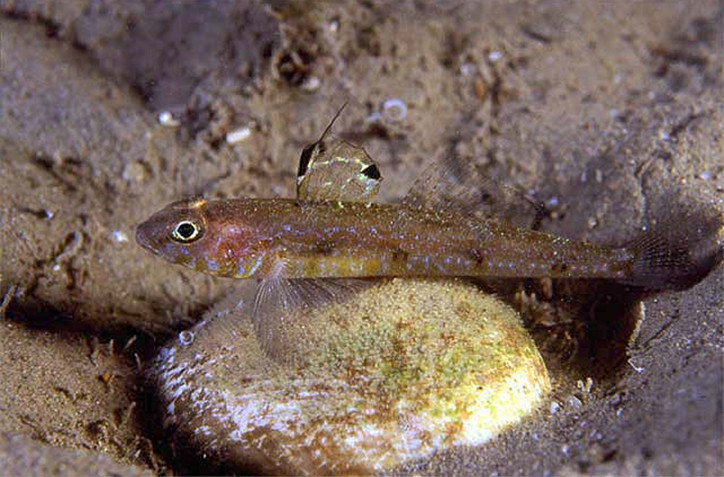
(Four-spotted goby. Photo by © David Luquet. fishbase.org)
It inhabits at depths of up to 333 meters. It dwells near the sandy bottom. The maximum recorded length is 8 cm. It feeds on zooplankton. It is a permanent inhabitant of the Adriatic Sea. It is more common in the northern part of the sea.

(Didogobius schlieweni. Photo by © Stefano Guerrieri. naturamediterraneo.com)
It inhabits the depth of 2-14 meters. It occurs in beds of Posidonia above the pebble and sandy bottom. It has nocturnal habits. The maximum recorded length is 4.9 cm. It feeds on zooplankton. It is a rare species until recently considered an endemic of the waters of the Adriatic Sea near the Croatian islands of Unije and Cres. Recently, this species has been found in other parts of the Adriatic and Mediterranean Seas.
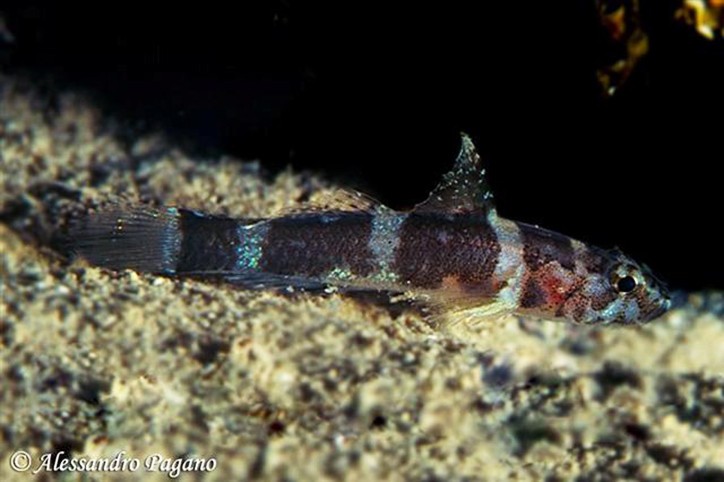
(Didogobius splechtnai. Photo by © Alessandro Pagano. fishbase.org)
It inhabits the depth of 5-56 meters. It occurs in underwater caves. The maximum recorded length is 2.8 cm. It is a rare species. It is an inhabitant of the Adriatic Sea.
Steinitz‘s goby (Gammogobius steinitzi).

(Steinitz’s goby. Photo by © Stefano Guerrieri. naturamediterraneo.com)
It inhabits the depth of 2-15 meters. It occurs near the coast in underwater grottoes. The maximum recorded length is 3.8 cm. It is a rare species. It is an inhabitant of the Adriatic Sea.

(Golden goby. Photo by © Ole Johan Brett. tropicalfavourites.com)
It inhabits the depth of 5-80 meters, usually 5-30 meters. It occurs above a rocky bottom with algal beds, near sheer coastal cliffs. It hides in crevices of rocks and other shelters. The maximum recorded length is 10 cm. It feeds on zooplankton. It is a permanent but infrequent inhabitant of the Adriatic Sea.
Bucchich‘s goby (Gobius bucchichi).
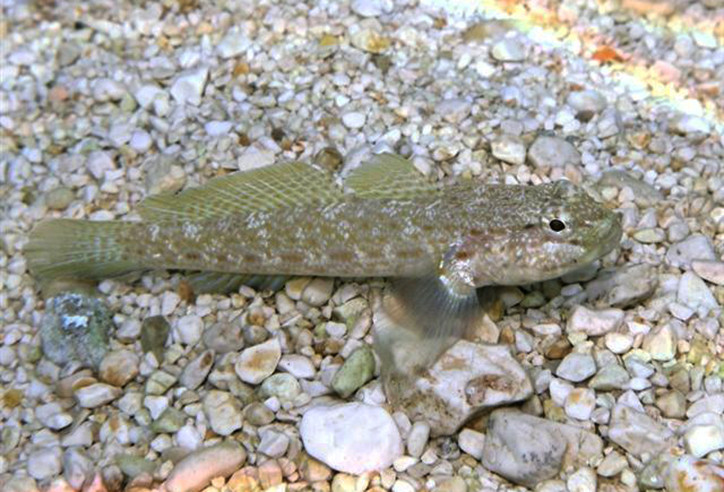
(Bucchich’s goby. Photo by © Roberto Pillon. fishbase.org)
It inhabits the depth of 1-30 meters. It dwells near a sandy and silty bottom covered with aquatic vegetation, often hiding in the tentacles of anemones. The maximum recorded length is 10 cm. It feeds on polychaetes, crustaceans, mollusks, and algae.

(Giant goby. Photo © tokaiki.net)
It inhabits at depths of up to 35 meters. It dwells near a stony bottom, overgrown with aquatic vegetation, and often occurs near river mouths. The maximum recorded length is 27 cm. It feeds on crustaceans, worms, and small fish. It is a permanent inhabitant of the Adriatic Sea.
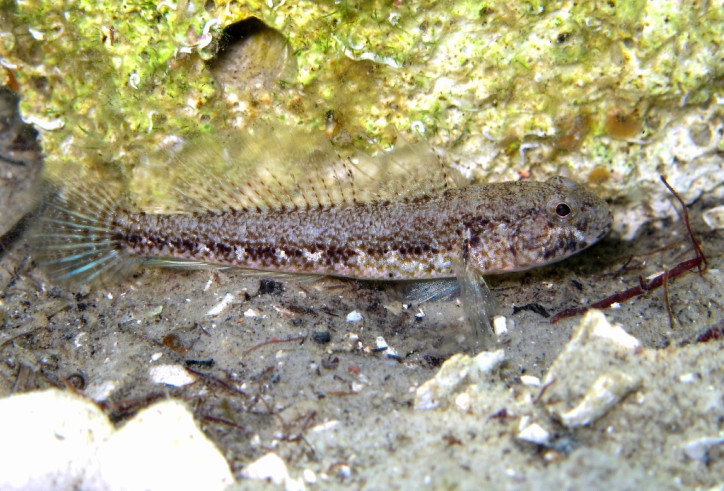
(Couch’s goby. Photo by © Roberto Pillon. fishbase.org)
It inhabits at depths of up to 10 meters. It dwells on a sandy and silty bottom, hiding under the stones. The maximum recorded length is 17 cm. It feeds on polychaetes, algae, crustaceans, bivalves. It is a rare species. It is found in the Adriatic Sea, in particular near the island of Krk in Croatia.
Red–mouthed goby (Gobius cruentatus).
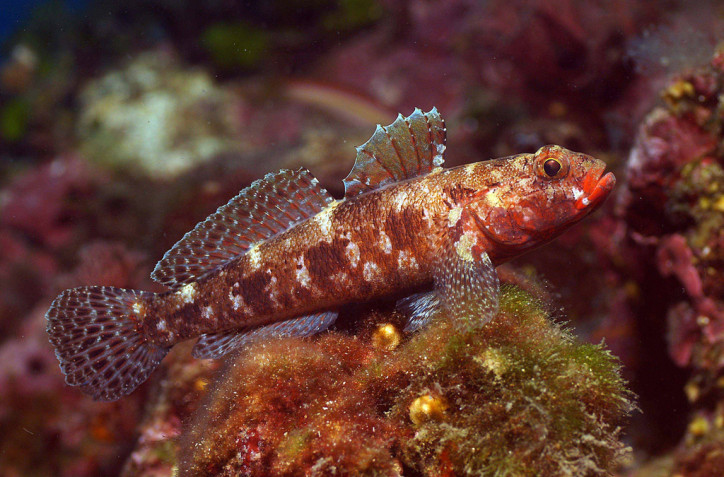
(Red-mouthed goby. Photo by © JorgeMF. flickr.com/photos/7221269@N02)
It inhabits the depth of 1-50 meters. It dwells near a sandy and rocky bottom, beds of underwater vegetation. The maximum recorded length is 18 cm. It feeds on zooplankton. It is a permanent inhabitant of the Adriatic Sea.
Sarato‘s goby (Gobius fallax).

(Sarato’s goby. Photo by © Fabio Vitale. naturamediterraneo.com)
It inhabits at depths of up to 32 meters. It occurs near the shore on a sandy bottom, hiding in the cracks of rocks, grottoes, and stones. The maximum recorded length is 9 cm. It feeds on zooplankton. It is a permanent inhabitant of the Adriatic Sea.
Slender goby (Gobius geniporus).
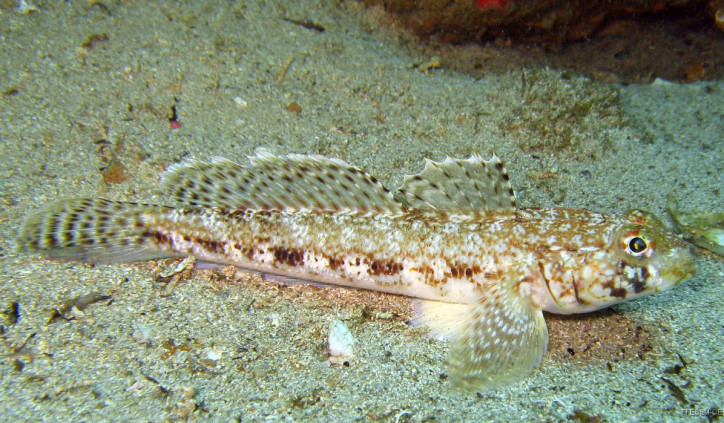
(Slender goby. Photo © cebs13.free.fr)
It inhabits at depths of up to 30 meters. It occurs near a sandy and silty bottom next to algae. The maximum recorded length is 16 cm. It feeds on zooplankton. It is a permanent inhabitant of the Adriatic Sea.
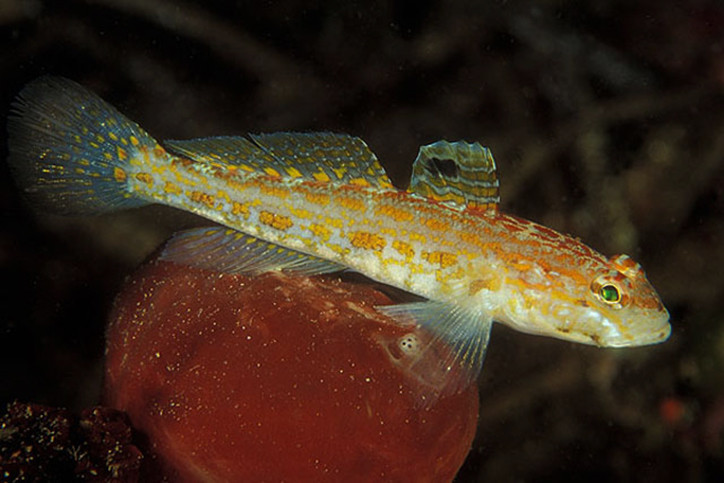
(Gobius kolombatovici. Photo by © Borut Furlan. fishbase.org)
It inhabits the depth of 15-90 meters. It occurs near a sandy and silty bottom with stones. The maximum recorded length is 9.2 cm. It feeds on zooplankton. It is a rare species. It is an endemic of the northern part of the Adriatic Sea.

(Black goby. Photo by © Lauri Urho. luontoportti.com)
It inhabits at depths of up to 96 meters, usually 1-50 meters. It often occurs near river mouths, in lagoons and coastal waters near a sandy and silty bottom, in thickets of algae. The maximum recorded length is 18 cm. It feeds on crustaceans, mollusks, and small fish. It is a permanent inhabitant of the Adriatic Sea.
Rock goby (Gobius paganellus).
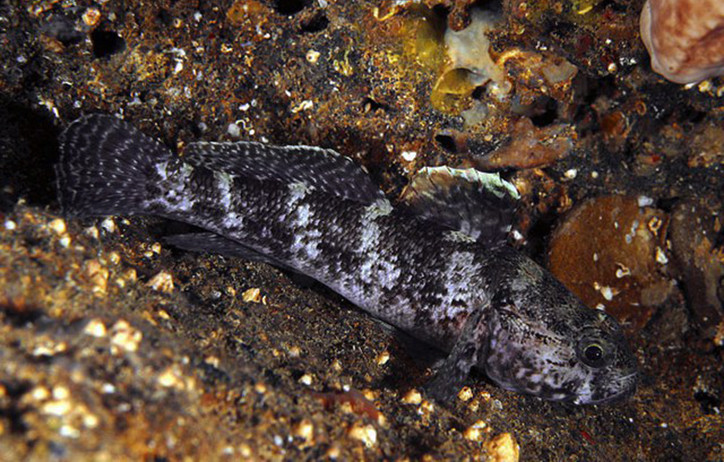
(Rock goby. Photo by © Stefano Guerrieri. fishbase.org)
It inhabits at depths of up to 15 meters. It occurs near a rocky, sandy and silty bottom overgrown with algae, hiding under the stones. The maximum recorded length is 13 cm. It feeds on crustaceans and polychaetes. It is a permanent inhabitant of the Adriatic Sea.

(Roule’s goby. Photo by © Xavier Salvador. Fundació Mar. flickr.com/photos/fundaciomar)
It inhabits at depths of up to 385 meters. It is a deep-sea species. It occurs near a sandy and rocky bottom. The maximum recorded length is 8 cm. It feeds on zooplankton. It is a rare species. It dwells off the eastern coast of the Adriatic Sea.
Striped goby (Gobius vittatus).
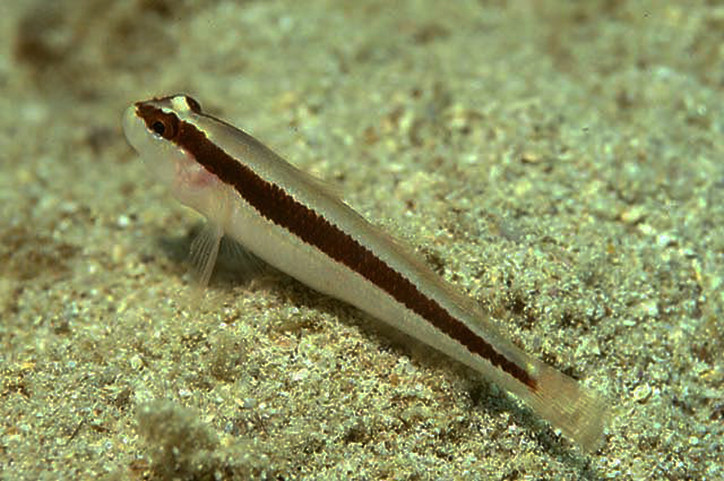
(Striped goby. Photo by © Jürgen Herler. fishbase.org)
It inhabits the depth of 15-85 meters, usually 15-50 meters. The maximum recorded length is 5.8 cm. It feeds on crustaceans and algae. It is a rare permanent inhabitant of the Adriatic Sea. It dwells off the coast of Croatia.
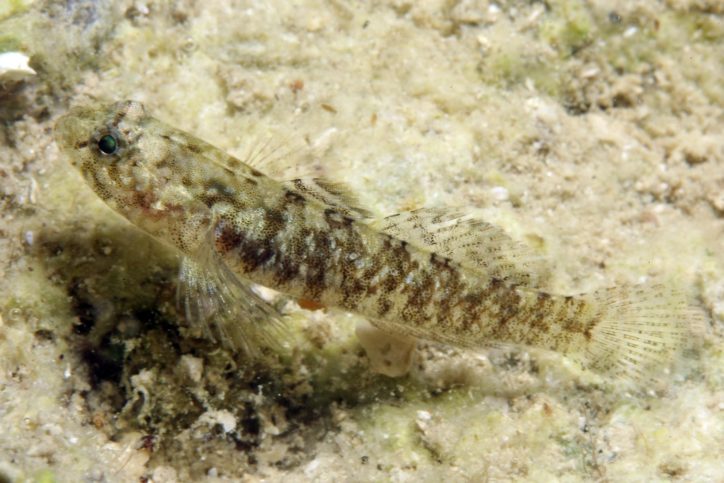
(Zebra goby. Photo by © Robert Patzner. iucnredlist.org)
It inhabits the depth of 0-5 meters. It occurs in the coastal zone, lagoons, hides under stones and among thickets of algae. The maximum recorded length is 5.5 cm. It is a permanent inhabitant of the Adriatic Sea.
Grass goby (Zosterisessor ophiocephalus).
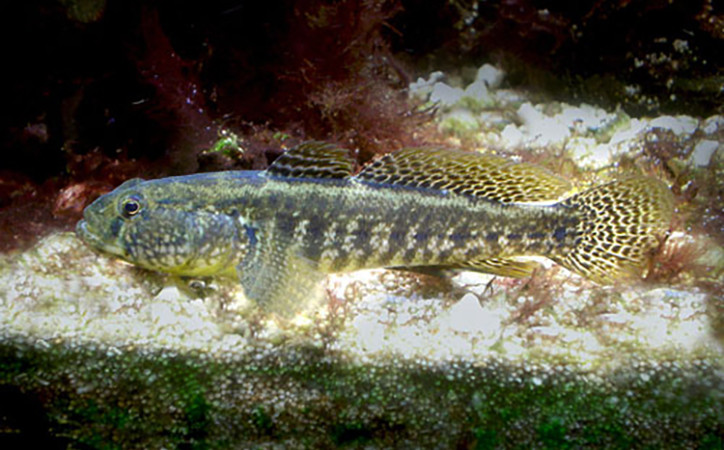
(Grass goby. Photo © akvarij.net)
It inhabits at depths of up to 30 meters. It occurs near a muddy bottom, in thickets of seagrass, often enters lagoons and bays. The maximum recorded length is 25 cm. It eats clams, shrimps, crabs, and small fish. It is a permanent inhabitant of the Adriatic Sea.
Caucasian dwarf goby (Knipowitschia caucasica).
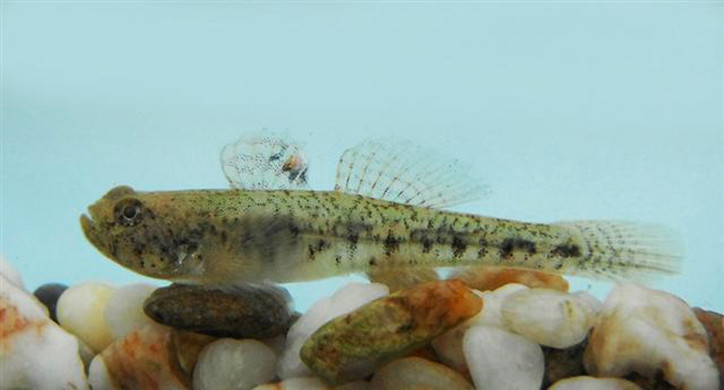
(Caucasian dwarf goby. Photo by © A. Harka. fishbase.org)
It inhabits at depths of up to 2 meters. It occurs near shallow areas near the coast with a large number of underwater vegetation, often in lagoons and bays. The maximum recorded length is 5 cm. It feeds on zooplankton. According to unconfirmed reports, it is found in the northern part of the Adriatic Sea.
Guillet‘s goby (Lebetus guilleti).

(Guillet’s goby. Photo by © Arif Can Keskin. evrimagaci.org)
It inhabits at depths of up to 30 meters, usually 8-10 meters. It occurs near the rocky bottom and shell rock. The maximum recorded length is 2.5 cm. It is a rare species. In the Adriatic Sea, it is found in its northeastern part near the coast of Croatia.
Fries‘s goby (Lesueurigobius friesii).

(Fries’s goby. Photo by © Jim Greenfield. fishbase.org)
It inhabits the depth of 10-130 meters. It occurs near a mud bottom. The maximum recorded length is 13 cm. It feeds on small crustaceans and mollusks. It is a permanent inhabitant of the Adriatic Sea.
Lesueur‘s goby (Lesueurigobius suerii).
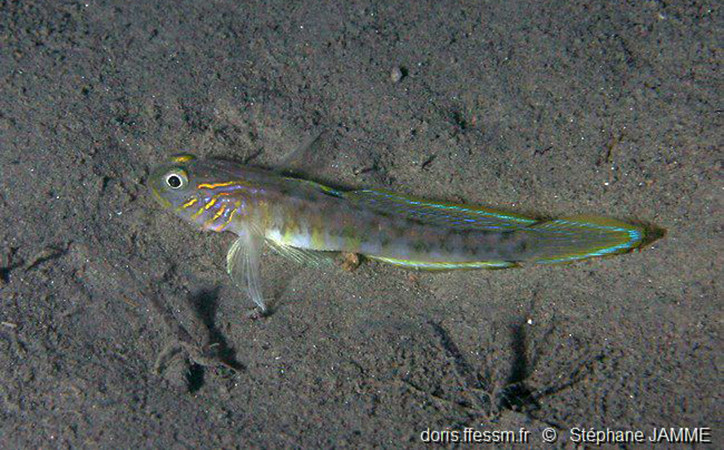
(Lesueur’s goby. Photo by © Stéphane Jamme. doris.ffessm.fr)
It inhabits at depths of up to 337 meters. It is a deep-sea species. It occurs near a muddy bottom. The maximum recorded length is 6 cm. It feeds on zooplankton. It is a permanent inhabitant of the north-eastern part of the Adriatic Sea.
Large–headed goby (Millerigobius macrocephalus).

(Large-headed goby. Photo © mladina.si)
It inhabits a depth of 6-10 meters. It occurs near a rocky bottom. The maximum recorded length is 4.4 cm. It feeds on zooplankton. It is a permanent inhabitant of the Adriatic Sea.
Coralline goby (Odondebuenia balearica).

(Coralline goby. Photo by © Stefano Guerrieri. fishbase.org)
It inhabits the depth of 20-70 meters. It occurs near a rocky bottom next to rocks and corals. The maximum recorded length is 3.2 cm. It feeds on zooplankton. It is a permanent inhabitant of the Adriatic Sea.
Bath‘s goby (Pomatoschistus bathi).
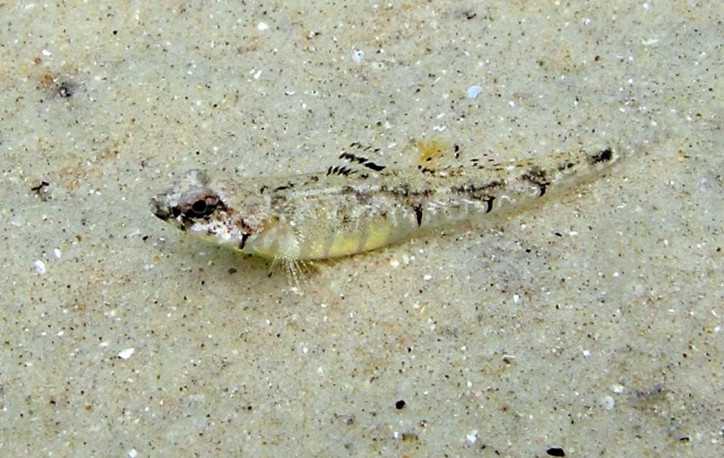
(Bath’s goby. Photo by © Roberto Pillon. marinespecies.org)
It inhabits a depth of 7-14 meters. It occurs near a sandy, pebble, and silty bottom, often near river mouths. The maximum recorded length is 3 cm. It is a permanent inhabitant of the Adriatic Sea.
Canestrini‘s goby (Pomatoschistus canestrinii).
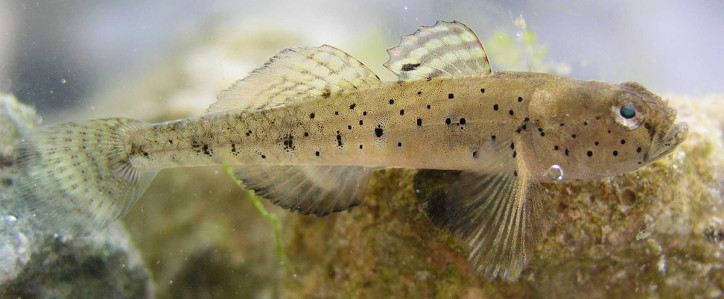
(Canestrini’s goby. Photo by © R. Šanda. europeana.eu)
It occurs in the coastal zones of lagoons, estuaries, enters freshwater; dwells near a sandy and silty bottom. The maximum recorded length is 5.5 cm. It is a permanent inhabitant of the Adriatic Sea. It is found north of the conventional line connecting the mouth of the Po River in Italy and the mouth of the Neretva River in Croatia. It rises and lives in rivers flowing into the sea. Introduced species in Lake Trasimeno (Italy).
Kner‘s goby (Pomatoschistus knerii).
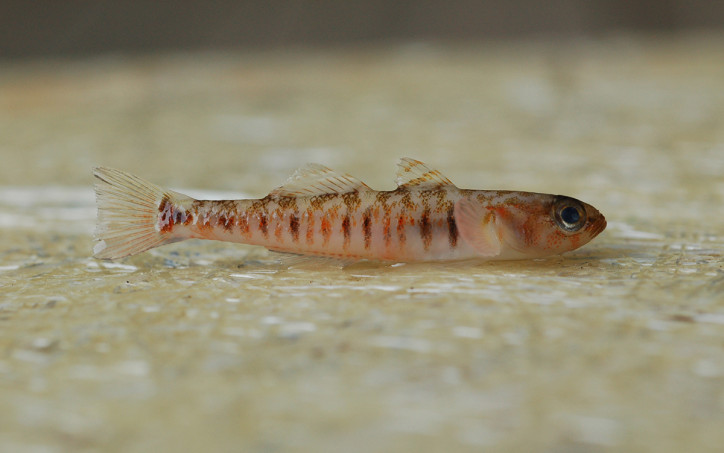
(Kner’s goby. Photo by © Marcelo Kovačić. fishbase.org)
It is a coastal species. The average size is about 3.5 cm. It is a permanent inhabitant of the Adriatic Sea.
Marbled goby (Pomatoschistus marmoratus).
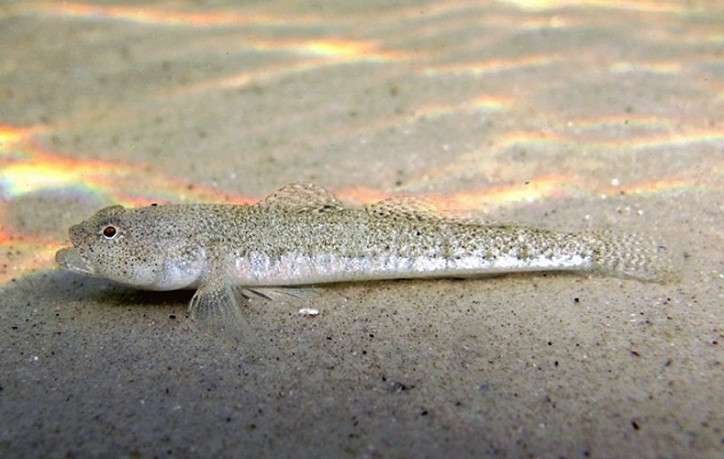
(Marbled goby. Photo by © Roberto Pillon. ittiofauna.org)
It inhabits the depth of 20-70 meters. It occurs near the sandy bottom. The maximum recorded length is 8 cm. It feeds on small crustaceans. It is a permanent inhabitant of the Adriatic Sea.
Common goby (Pomatoschistus microps).
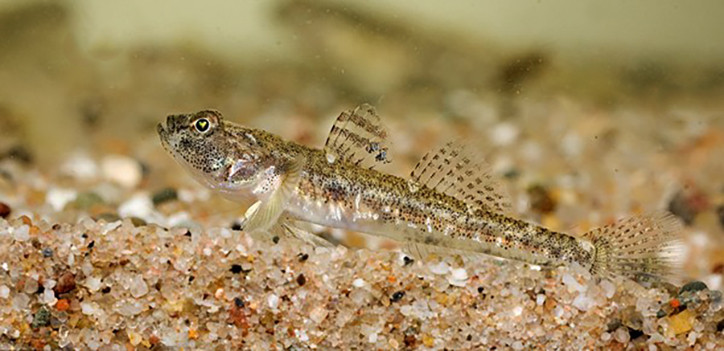
(Common goby. Photo © ravon.nl)
It inhabits at depths of up to 12 meters. It occurs near a sandy bottom often comes into estuaries, lagoons and salt marshes connected to the sea, river mouths. The maximum recorded length is 9 cm. It feeds on small crustaceans, worms. It is a rare inhabitant of the Adriatic Sea.
Sand goby (Pomatoschistus minutus).
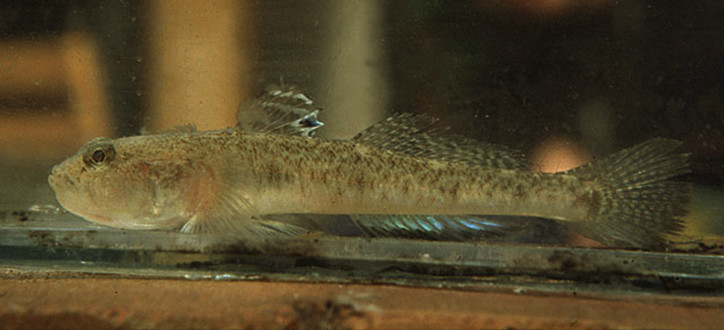
(Sand goby. Photo by © Klaus Busse. fishbase.org)
It inhabits the depth of 4-200 meters. It occurs near a sandy and silty bottom often found in estuaries. The maximum recorded length is 11 cm. It feeds on zooplankton. It is a permanent inhabitant of the Adriatic Sea.
Norway goby (Pomatoschistus norvegicus).
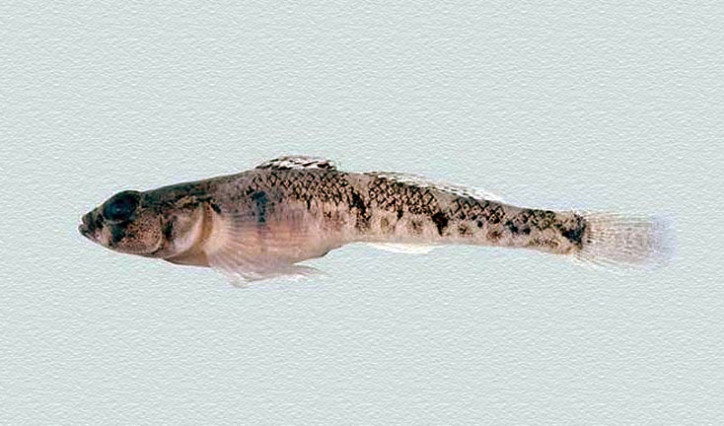
(Norway goby. Photo © ittiofauna.org)
It inhabits a depth of 10-20 meters. It occurs near a muddy bottom. The maximum recorded length is 8 cm. It feeds on zooplankton. It is a rare inhabitant of the Adriatic. Registered single encounters in the northern part of the sea.
Painted goby (Pomatoschistus pictus).

(Painted goby. Photo by © Andy Rapson. fishtanksandponds.co.uk)
It inhabits the depth of 1-55 meters. It occurs near a pebble and sandy bottom. The maximum recorded length is 6 cm. It feeds on small crustaceans. It is a permanent infrequent inhabitant of the Adriatic Sea.
Quagga goby (Pomatoschistus quagga).

(Quagga goby. Photo by © Roberto Pillon. marinespecies.org)
It occurs near the coast in beds of underwater vegetation. The maximum recorded length is 6 cm. It is a permanent infrequent inhabitant of the Adriatic Sea.
Ferrer‘s goby (Pseudaphya ferreri).
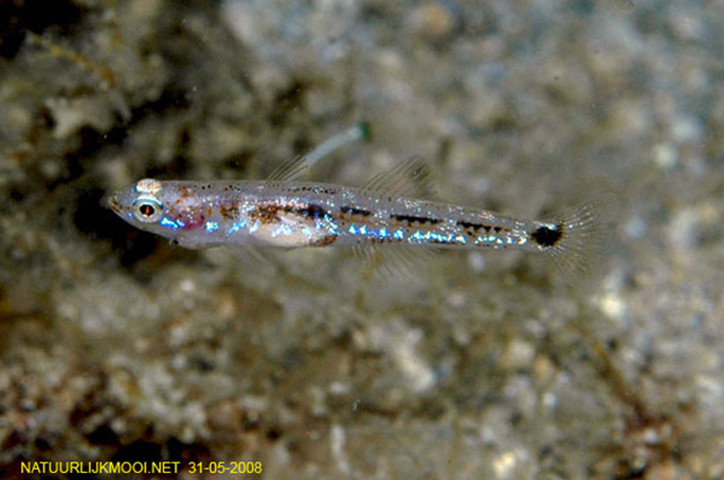
(Ferrer’s goby. Photo by © Mat Vestjens. fishbase.org)
It inhabits the depth of 1-10 meters. It is a pelagic species. It occurs above the sandy bottom. The maximum recorded length is 3.5 cm. It is a permanent inhabitant of the Adriatic Sea.
Grotto goby (Speleogobius trigloides).
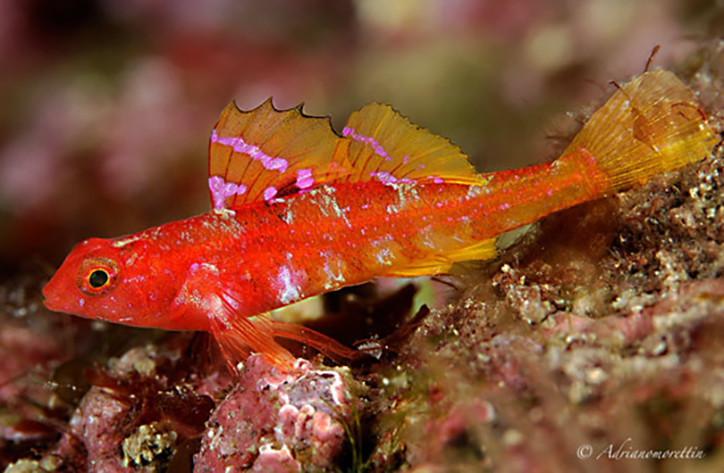
(Grotto goby. Photo by © Adriano Morettin. colapisci.it)
It inhabits the depth of 8-25 meters. It occurs in dimly lit underwater caves and grottoes. The maximum recorded length is 1.8 cm. It is a permanent inhabitant of the Adriatic Sea, it is an endemic species, is more common near the islands of Croatia.
Leopard–spotted goby (Thorogobius ephippiatus).
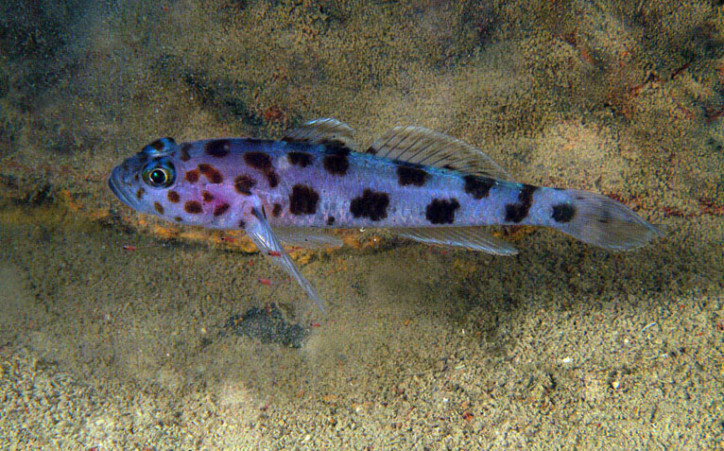
(Leopard-spotted goby. Photo by © Stefano Guerrieri. naturamediterraneo.com)
It inhabits the depth of 6-40 meters, usually 6-12 meters. It occurs near the rocky coasts. The maximum recorded length is 13 cm. It feeds on crustaceans, gastropods, and algae. It is a permanent inhabitant of the Adriatic Sea.
Large–scaled goby (Thorogobius macrolepis).

(Large-scaled goby. Photo by © Jürgen Herler. fishbase.org)
It occurs in the coastal zone. The maximum recorded length is 6.5 cm. It is a permanent inhabitant of the Adriatic Sea.
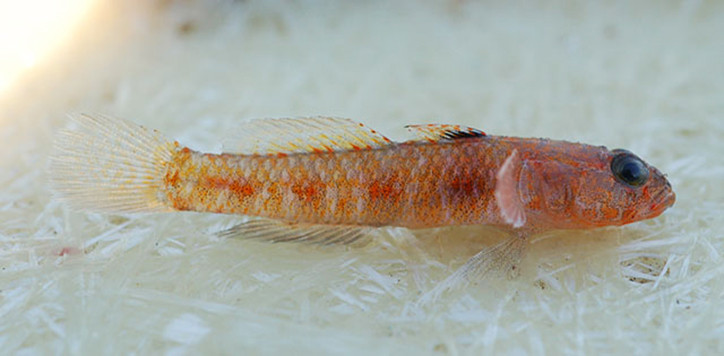
(Vanneaugobius dollfusi. Photo by © Marcelo Kovačić. fishbase.org)
It inhabits at depths of up to 115 meters. It occurs near a sandy, silty and hard bottom. The maximum recorded length is 4 cm. It is a rare little-studied species. In the Adriatic Sea, this species is found off the coast of Croatia.